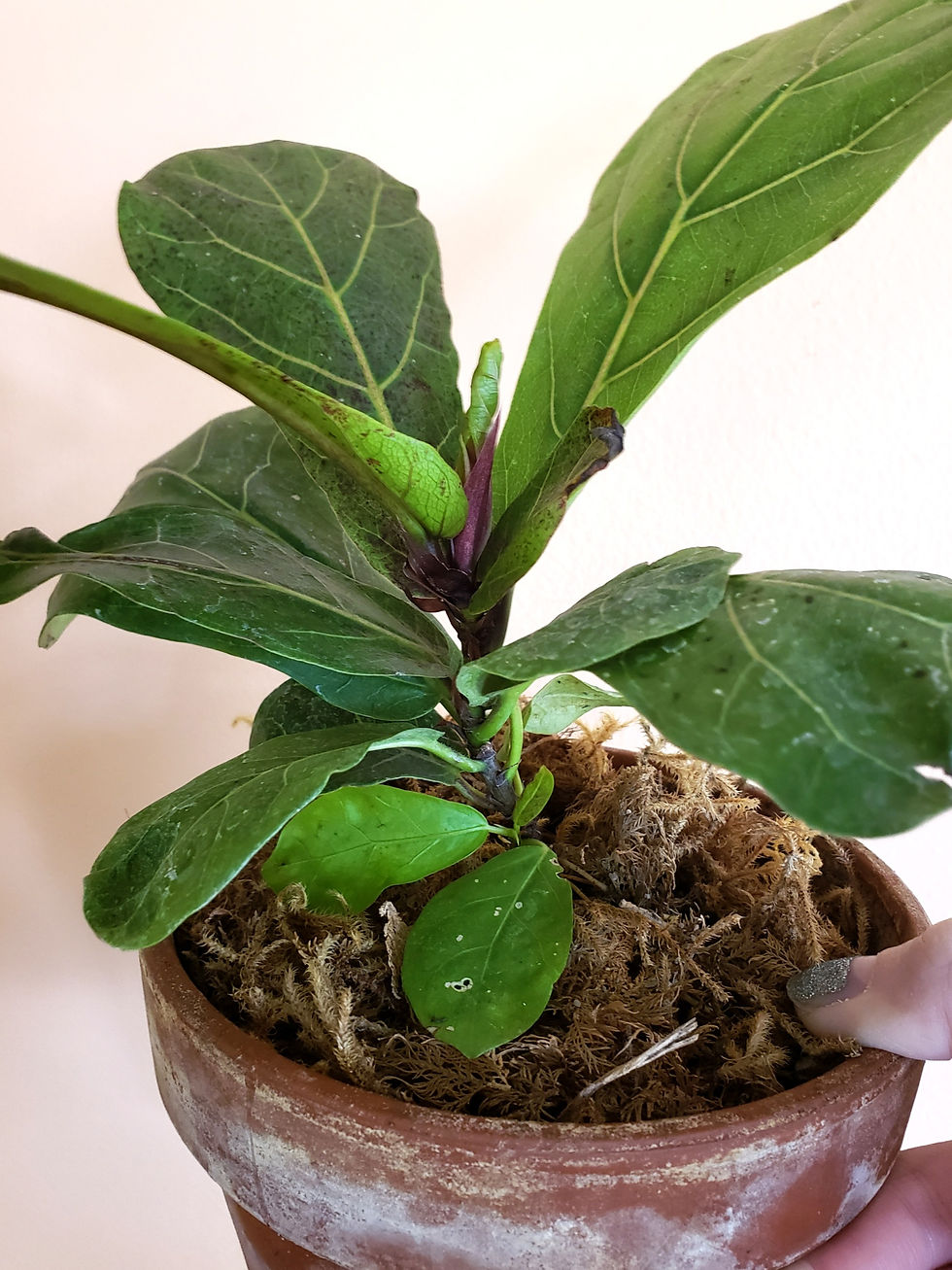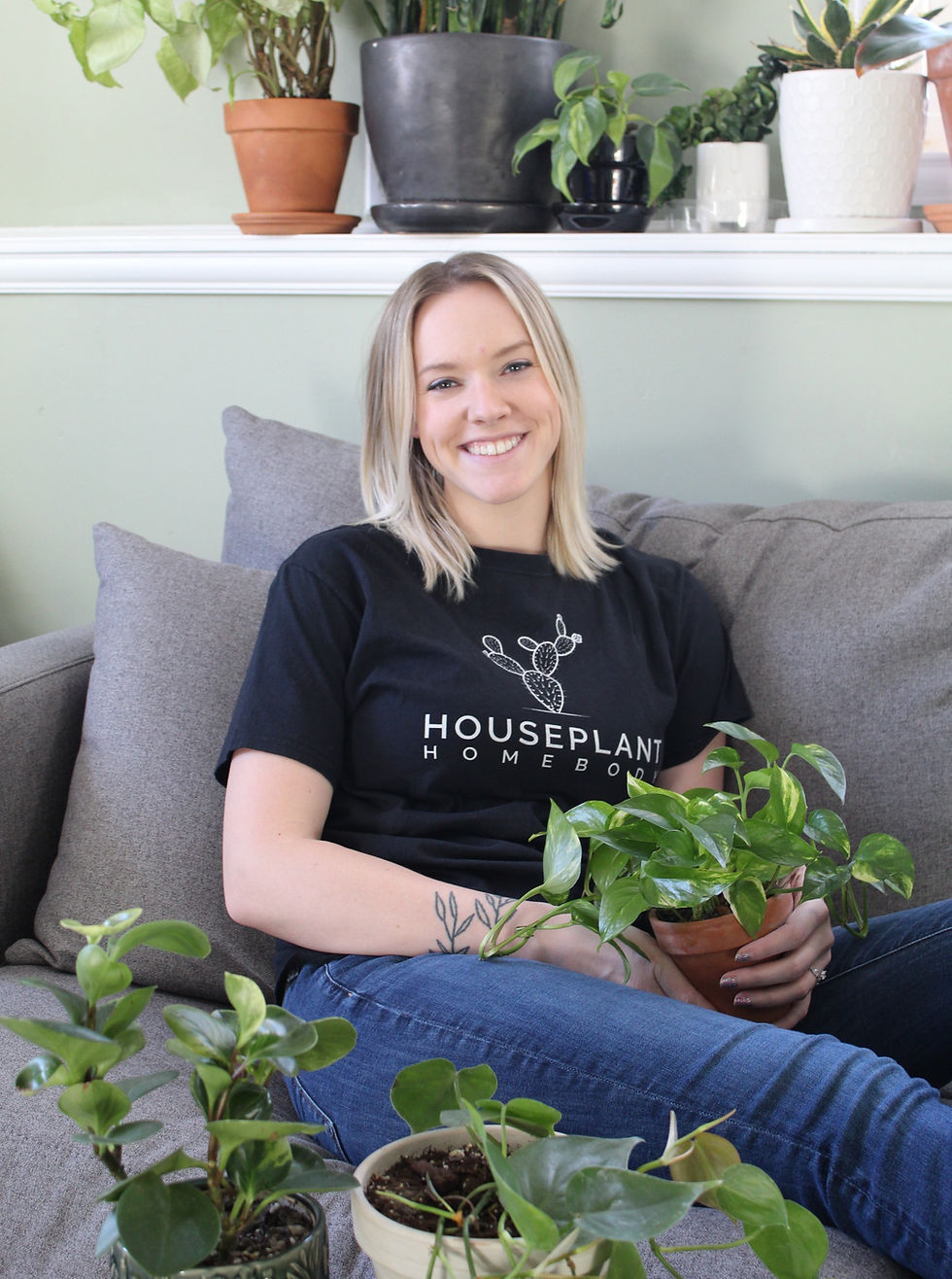Fiddle Leaf Fig- Plant Bio: Podcast Ep#32
- Owner: Holly Dz

- Apr 26, 2021
- 6 min read
Updated: Oct 10, 2021
This is BY FAR the most popular houseplant around the world. You can open any home magazine and you will more than likely find one of these in some of the pictures. They make a big impact in a space by filling any corner with lush, large green leaves.
Botanical Name
Ficus lyrata
Common Names
Fiddle Leaf Fig, Banjo Ficus, FLF
Variety Names:
Most commonly found in the original Ficus lyrata variety but smaller and more unique cultivars have been created such as Compacta, Bambino, Little Fiddle, and Suncoast. These do come in variegated forms but are very rare, more rare than a variegated Monstera!
Sun Requirements:
The more light, the better! Bright, indirect is best but if you have a location with some direct sunlight, this FLF can handle it! I currently have mine sitting in a South window and it is doing great! It gets filtered light in the morning and direct sunlight until about 2pm. When I worked at the garden center, I planted one in a container at the front of the store. That location was on the west side of the building which had bright, direct light for most of the day and it actually did wonderfully!
Water Requirement
The main component to succeeding with FLFs is water. Never allow this plant to dry out completely and always water consistently. Water when the top layers of soil are dry to keep it evenly moist. This may take some trial and error and it really depends on the environment you give it. If you can try to water on the same day, with the same amount of water, that will help with consistency!
Currently I water mine every Sunday. I try to be very consistent with this because I know this is a key to success and I am determined not to fail!!! If you are worried about overwatering or underwatering, FLFs do give you signs that they are stressed. If you are noticing yellowing or browning leaves there may be an issue. Unfortunately browning or yellowing could be signs of underwatering or overwatering! In my past experiences, I've underwatered my FLF. The leaves started to turn brown and crispy, dropping from the bottom of the plant moving upward. It almost looked like the brown was spreading on the leaves and by the time I got to watering it, it was too late. For the first few months, it is good to closely monitor you FLF and understand what it needs. This is not a beginner plant by any means.
Increased humidity can be a helpful component to this houseplant's success but I have seen several houseplant lovers on Instagram that don't provide extra humidity and their plant is doing fine! I do have mine sitting near my humidifier and I mist the leaves every few days, but our home is still pretty dry overall.

Fertilizer
As I always say, there are LOTS of way to fertilize plants. Unless you are extremely over fertilizing your plant, there isn't necessarily a wrong way to do this. I currently use Espoma Indoor! Liquid Plant Food and I fertilizer every 2 weeks when I water my plants, starting around the end of February through October. I honestly probably only fertilize once or twice in winter because the plant isn't as active! I use about 1/2 to 3/4 the recommended amount of fertilizer because I would rather under fertilize than over fertilize my plants.
Here are what another source said...
The Complete Houseplant Survival Manual by Barbara Pleasant says, "Feed three times a year (spring, midsummer and fall) with a high nitrogen foliage plant food that includes micronutrients." If you are looking for a good fertilizer with micronutrients, Fox Farm is a great brand!
Fertilizing is completely up to you! There are MANY products out there you can try but an overall rule of thumb for houseplants is that it is best to under fertilize than over fertilize. Always use the recommended amount or less when applying your fertilizer to houseplants.

Propagation
You can propagate FLF by stem cuttings or air layering.
Stem Cutting: Cut the stem just below a leaf node. Make sure you have at least 12" of the stem for propagating. Leave at least one leaf at the top of the stem. Pull off any leaves at the leaf nodes you may be putting in water or soil.
It may take about 2 months before you see a healthy set of roots at the leaf nodes.
Air Layering: This isn't something I've tried yet simply because my plants haven't been big enough to test it out! It is a type of propagation that is frequently used because you do not have to remove a stem from the parent plant in order to grow roots! I have seen several people do it successfully! What you need to do is cut a wound in the stem, no more than about a third of the way deep. You can do this in the middle of the branch, and you do not need to do it directly near a node. Wrap moist sphagnum moss around the cut area then surround the moss in plastic wrap. You can tie off above and below the moss to hold the wrap in place. Allow space for you to water when the moss in the plastic wrap is drying out. After a couple months, check the moss to see if roots have successfully grown. If they have, cut just below the air layering and plant into a new container!
Other Facts
Part of the Moraceae Family (Mulberry or Fig Family).
In its native habitat of Western Africa, this would be a pretty large tree growing anywhere from 60-100' tall.
When grown in its native habit, it does grow fruit. As a houseplant, you won't see any fruit.
In your house, you can grow between 4' to 10' tall depending on the variety. You may have an even taller plant if you have room!
Longevity for this plant can be many years or whenever your home runs out of room! Be prepared to give this guy space or purchase a cultivar that is known to stay smaller in maturity.
You can cut back your FLF if needed! Just cut above where a leaf is forming. You can propagate the part you cut off too!
If you have a large FLF, it is normal for the bottom leaves to drop off occasionally.
Remember to clean the leaves occasionally to allow for proper photosynthesis and to keep your plants free of pests.
Toxic to pets and humans. Check out Podcast Ep#31 for more info or the corresponding Blog post!
Instagram Q&A
I asked followers if they had any specific plant questions I could address in this podcast and blog. Here are the questions and answers for Fiddle Leaf Fig...

"Why do red dots form on new leaves?"
These red spots are formed by an influx of water. If the FLF takes in more water than its expecting, the leaves' cells burst and die. This process is called Edema which results in the tiny red or brown dots of the leaves. This image of my FLF shows a great example of Edema. I bought the plant like this because I knew it could recover from that issue easily.
"What do large brown splotches on the lower leaves generally indicate?"
This depends! This more than likely is a watering issue but it could be a temperature issue. Make sure your FLF is not directly near a place in your home that abruptly changes temperature (I.E. air conditioner, heater, drafty windows and doors in winter). If that looks okay then it may be lack of water, or too much water. You need to keep this plant constantly moist but never drowning in water. Watering around the same day, with the same amount of water, can help with the consistency factor that we learned is oh-so important with this kid!
#ficuslyrata #fiddleleaffig #banjoficus #bambinoficus #propagation #crazyplantlady #ihaveathingwithplants #plantcommunity #urbanjungle #funfacts #podcast #houseplanthomebody #blog #helloplantlady #plantparenthood #fortheloveofplants #plantaddict #plantgang #plantsarefriends #thatplantlife #houseplantlove #tellyourplantfriend #houseplantblog #houseplantpodcast #plantssparkjoy #plantsmakepeoplehappy

WANT TO LISTEN?
Go to Apple Podcasts, Amazon, Spotify, Stitcher, Google Podcasts, and PodBean. Search for Houseplant Homebody to hear this episode and MANY more! You can also listen directly on my website under the Podcast page!
DON'T FORGET TO FOLLOW!
Stay connected on Instagram, Facebook, and Pinterest @houseplanthomebodyllc.
SAVE, COMMENT, LIKE, FOLLOW, SUBSCRIBE, and SHARE.
All your engagement on my podcasts, blogs, and social media posts help other plant lovers find me too!
FUN FACTS:
I've had three FLFs in my lifetime! The first two I had, I underwatered both of them and killed them. I thought the soil needed to be completely dry before watering again but clearly I was wrong. The one I currently have, I bought from Watter Farms in Neenah, WI for only $4. It only had a few leaves and was about 4" tall. After a few months, it has formed 3 new leaves and it looks very healthy!
Comment your FLF experience below!!!

Always written with extreme plant passion!
Love, Holly








Comments